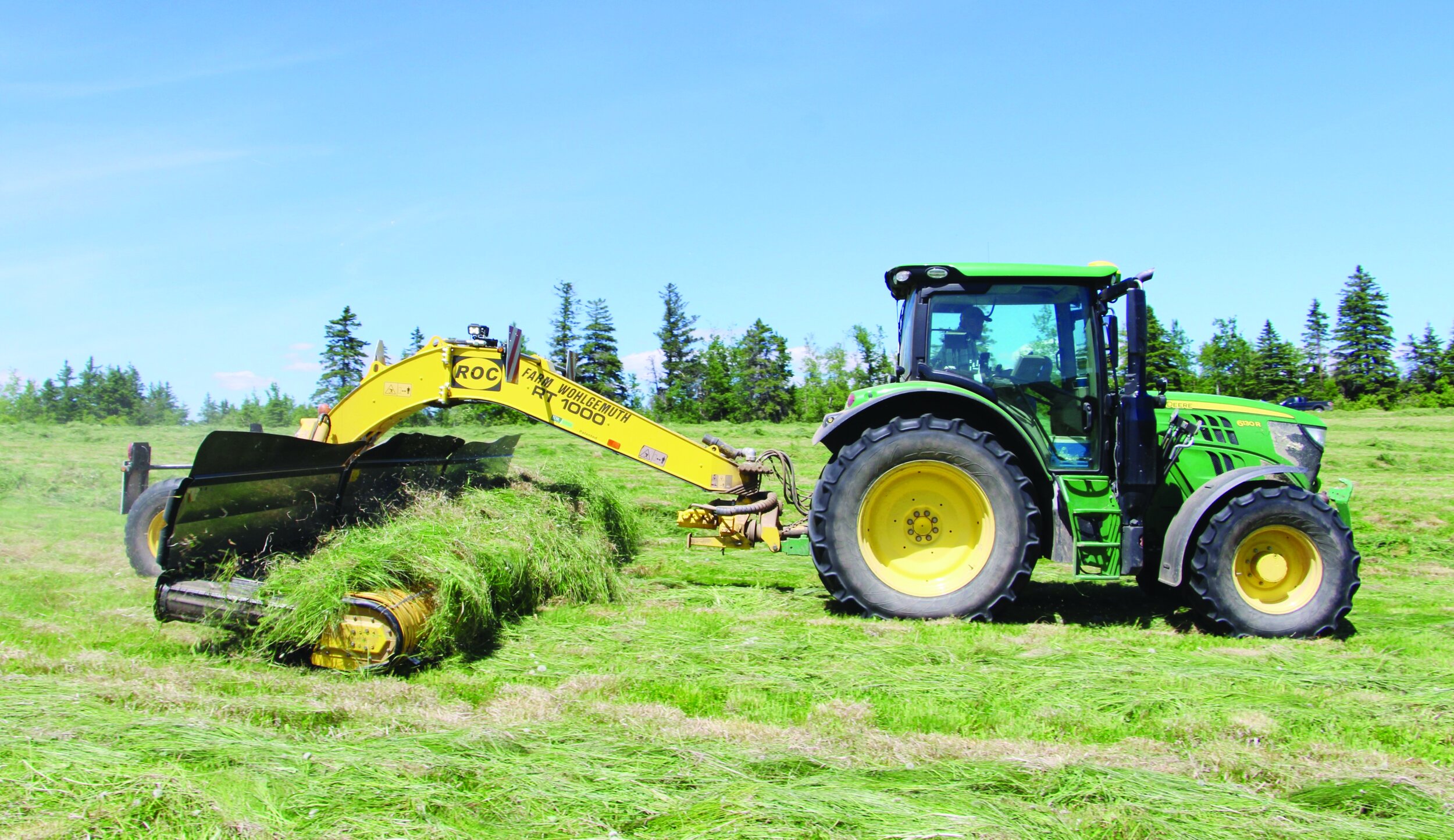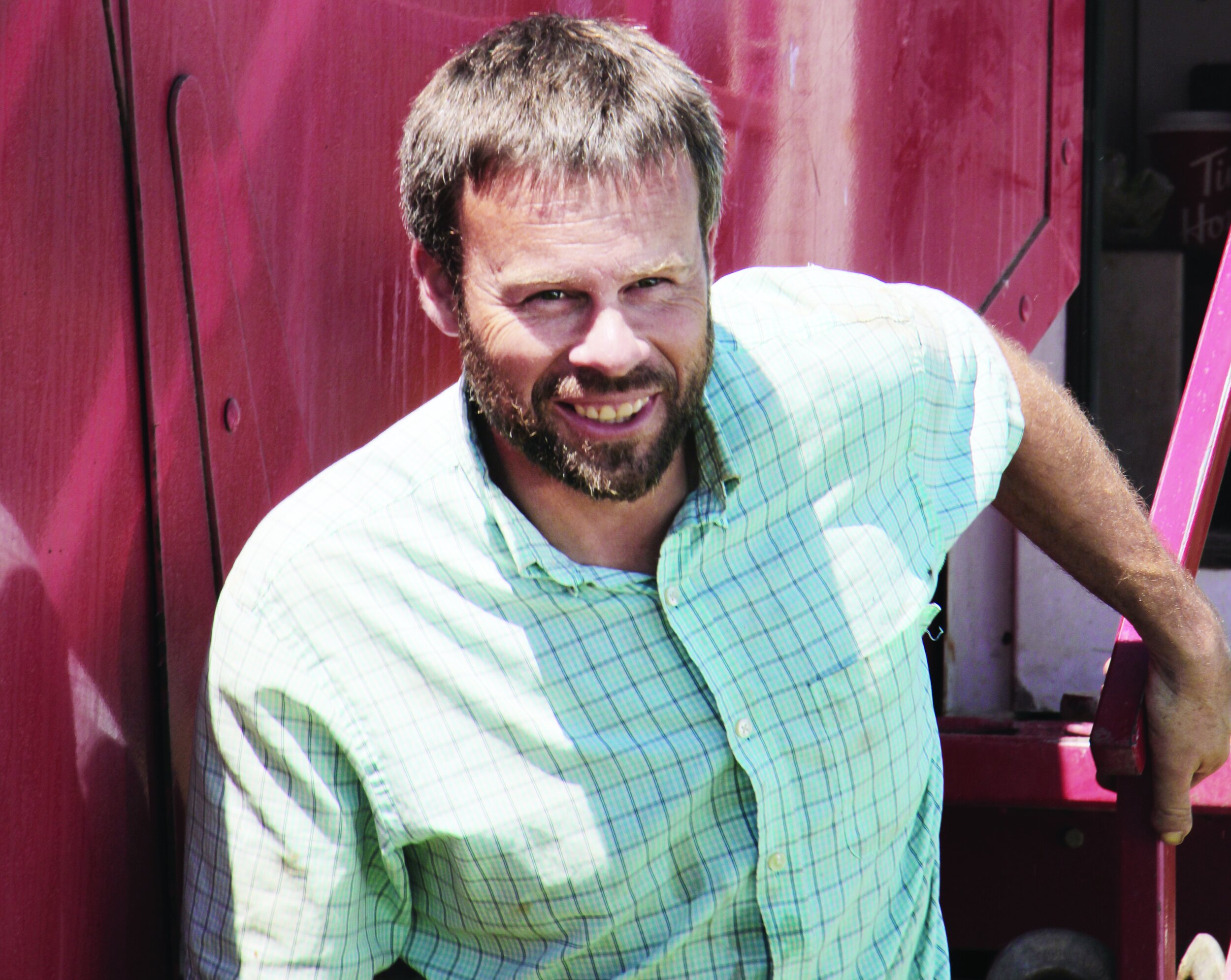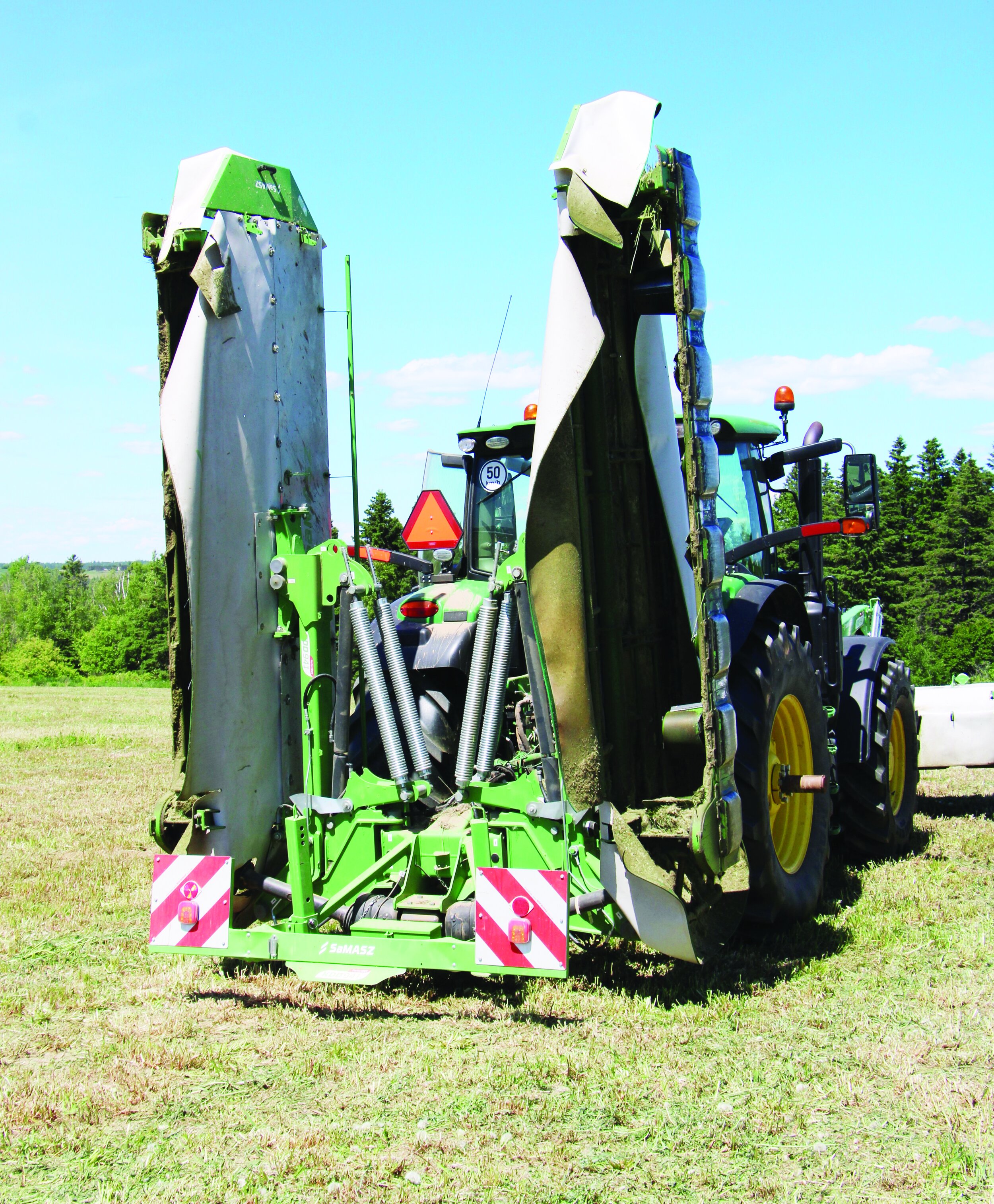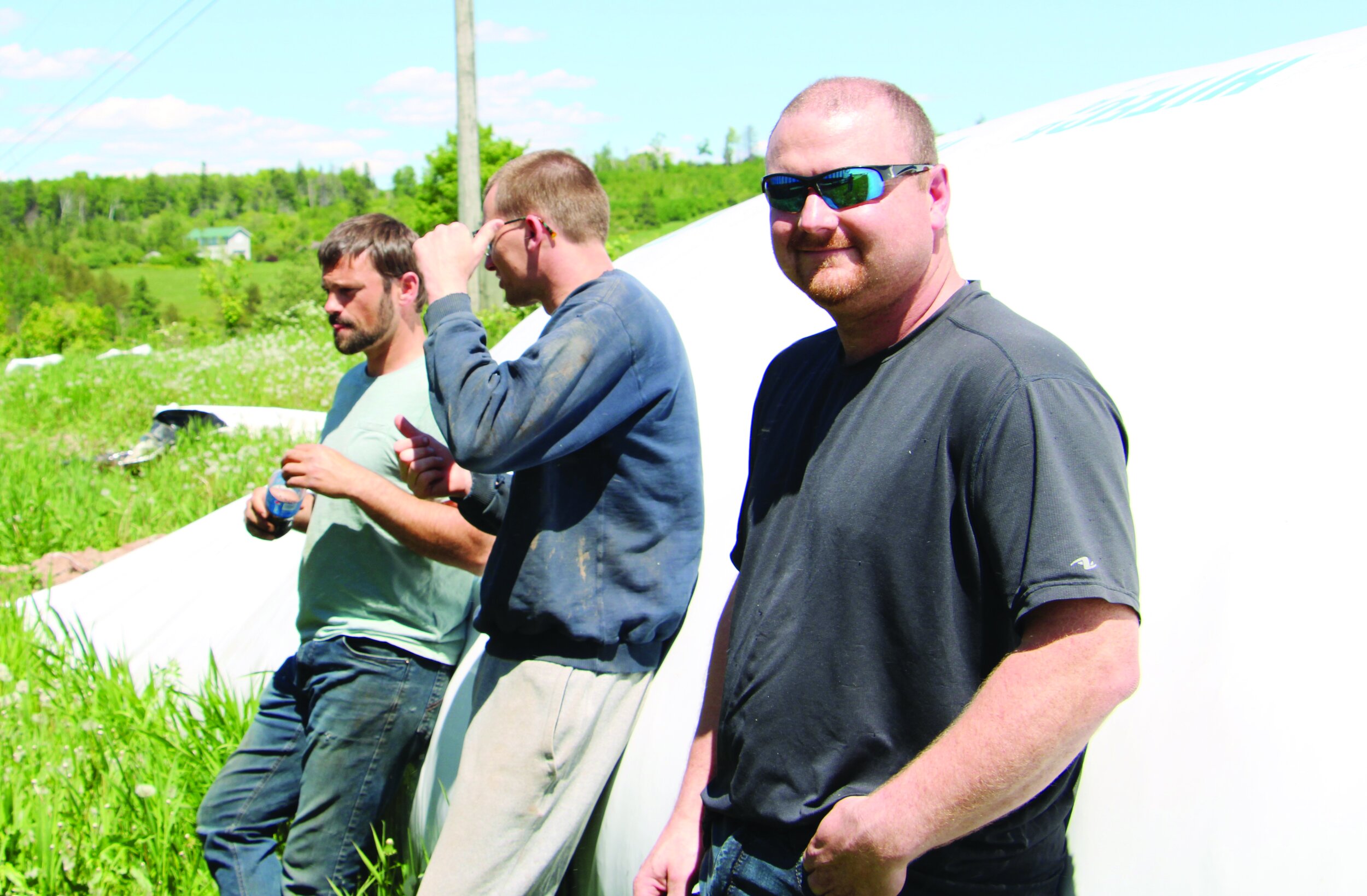“This year, 285 acres done in two days!”
/by George Fullerton
Dairy farmer Danny Clain of Anagance in southeastern New Brunswick was all smiles during the first week of June as Ben and Jordan Wohlgemuth’s custom harvesting crew packed silage bags full of his first-cut grass and legumes.
“With the Wohlgemuths, I can get done in a couple days what used to take us two months to do on our own,” said Clain. “Right now, the grass is at its nutritional peak and we have it stored. This will feed the milking cows and put milk in the tank.”
Ben Wohlgemuth is the spokesman and logistics manager for the Wohlgemuth custom crew. He and his brother Jordan own the equipment and are both operators.
The Wohlgemuths begin their custom contracting by planting corn through the spring, starting out near their home in Summerfield in Carleton County in west-central New Brunswick. The corn planting contracts extend from Plaster Rock to the north and Mactaquac to the south. In June, the crew moves into forage harvesting, starting in Salisbury, which is in the southeast of the province.
“The grass is earlier around Salisbury, and then we work back toward home in Carleton County,” said Ben Wohlgemuth. “We do grass in Saint-Quentin, which is as far north as we go. Mostly we do first-cut silage, but we do some second and third cut for some farmers.”
ROUGH SCHEDULE
Late each winter, Wohlgemuth contacts farmers they’ve worked for in the past to see if they’re wanted again during the upcoming season.
“And then we make up a rough schedule,” he said. “Like everyone else, we work according to the weather. When it is too wet to work, we park like every farmer and wait for the ground to dry out, so our schedule is only a best guess. This year, we could not complete corn planting in Carleton County because it was so wet. Here we are, early in June, putting up silage in Anagance, and the Carleton County farmers with corn to plant are saying it is still not dry enough to finish planting those few hundred acres.”
The equipment and the teamwork are pretty impressive. Mowing is done with a 30-foot SaMASZ batwing disc mower powered by a 175-horsepower John Deere tractor. The 29-foot merger, powered by a 130-horsepower tractor, windrows the forage. The forage chopper is a self-propelled, 490-horsepower 8300 John Deere with a 10-foot header. Three trucks with apron-chain unloading deliver chopped forage to the silage bag packer. The 240-horsepower Versa bag packer is self-propelled and rated to pack seven tons of forage per minute.
“If everything is going right with a good crop, smooth fields, good weather, and no breakdowns, we can pack 1,400 to 1,500 tons per day into silage tubes,” said Wohlgemuth.
Moving the equipment is another logistical challenge.
“We drive the mower to different operations,” said Wohlgemuth. “That might sound like a time-consuming process, but we figure it is the most efficient way. If we hire a truck and he is late, the mower is not productive. We have to mow at least a day ahead of merging and chopping – maybe two days if it is heavy legumes – so the mower can start on a new farm while we are still chopping and packing. Travelling is a fuel and tire-wear cost, but hiring a float truck has costs and scheduling issues too. The merger and tractor are hauled on a float behind one of our trucks. The chopper is loaded on a trailer and towed by another truck. The packer has a pintle hook and is towed on its own wheels behind the third truck.”
STATE-OF-THE-ART
Wohlgemuth said that they like to keep their equipment as up to date as possible, not only to help control fixed costs but also to maintain their high efficiency and production. They got a new bagger in 2017, a new merger a couple of years later, and a new chopper this year.
“The merger is twice as big as our previous merger, and it has increased our efficiency a lot,” said Wohlgemuth, adding that it merges about twice as fast as the old one.
Wohlgemuth has a John Deere app on his smartphone that allows him to see a map of the farm fields and each John Deere machine as it works each field.
“The app allows me to see where everyone is and how the operation is progressing,” he said. “It will even tell me their speed and fuel consumption. We use auto steer, which allows the mower to be in the sward all the time. The guidance system also helps the merger make a neat eight-foot windrow, which fits our (chopper’s) 10-foot header most efficiently. Auto steer is also important to ensure we get 100 percent coverage when we are seeding or planting.”
Wohlgemuth also uses CB radios to keep in constant communication with his operators and truck drivers.
AUTUMN WORK
As the forage season winds down, the Wohlgemuth crew park the mower and merger and typically start the chopped corn silage harvest early in September, although it may start later depending on the weather and crop maturity.
“We usually start corn silage in Sackville and work our way back to Carleton County,” said Wohlgemuth. “We usually begin making cob meal around the middle of October.”
At home in Summerfield, Ben Wohlgemuth’s family manages 30 cow-calf pairs on an intensive rotational pasture system, as well as other farmstead operations. His wife Loree and their children Trudy, Lee, Jack, Joseph, Anika, and Myles manage the cattle and other farm chores through the week when contracting is going on. The Wohlgemuths also have 50 stocker cattle on island pasture in the Saint John River.
Jordan Wohlgemuth’s wife Monique and their children Skyler, Theo, and Iyla handle things at their home, also in Summerfield.
“Wet weather is always a concern,” said Ben Wohlgemuth. “And mud is not our friend! I tell our truck drivers, we always get challenged by mud. Sometimes fields get just too wet to finish; we end up spending too much time pulling equipment out and production goes way down.”
Two of the Wohlgemuth trucks are equipped with tire-inflation apparatuses on their drive axles. Lowering air pressure in the tires aids traction in muddy conditions, but the system has its limits, and towing trucks or the chopper is not uncommon.
CUSTOMER SERVICE
“Some farmers request certain forage chop length,” said Wohlgemuth. “We adjust the chopper to meet their request. Adjusting the chop length slows down our production some, which adds cost for the farmer, but they get the chop they want.”
Via his phone app, Wohlgemuth recognizes when there is a field change and uses a permanent marker to identify the change on the side of the silage bag. This important piece of information allows the farmer to ensure forage samples are taken for different production qualities and fields so that feed rations can be balanced accordingly.
“Some farmers hesitate to start cutting if the weather forecast looks bad,” said Wohlgemuth. “Sometimes, we call another farmer and they might gamble and get us to start cutting. Weather is a constant unpredictable part of our business.
He added, “Last year, we chopped about 4,000 acres of forage and 2,000 acres of corn. In our early years of operation, we did only about one-third that amount. When we started in 2011, there were not many for-hire custom contractors in New Brunswick, but there are a few more now. Contract harvesting is a very important service for many farm operations across the province.”
Some farmers hire the Wohlgemuth crew to complete their entire forage harvesting operation, from mowing to sealing the silage tubes, while other farmers do some of the work themselves.
“Wietze Dykstra in Knowlesville does his own mowing with his 30-foot mower and we just handle the merging, chopping, and hauling to the bunkers or field piles,” said Wohlgemuth.
STRESS REDUCTION
Danny Clain said the service is invaluable.
“We have had the Wohlgemuths doing silage for the past six years,” he said. “It simplifies making the first-cut silage and it avoids a great deal of stress. We require two fewer summer staff, and it gets done with no unexpected expenses (breakdowns) on our part. The Wohlgemuths know the farm, where fields are, where the connecting roads are, where the wet spots are. It all gets done very efficiently. This year, 285 acres done in two days!”
Clain added, “We need good forage to make milk. Forage is at its peak nutritionally for only a short window. To get the highest-quality silage, we have to make silage in just a few days. If first-cut silage-making extends to a few weeks, toward the end of that period the quality is much lower than we want to see.”
He went on to emphasize that having high-quality silage offsets the need to supplement feed with expensive rations delivered to the feed tanks.
Clain added that chopped silage works a lot better than round-bale forage in his TMR (total mixed ration) mixer, providing more effective mixing and a lot less mechanical wear.
Wohlgemuth said that custom contracting has lots of challenges, along with lots of rewards. He added that he’s proud of his crew for the high-quality service they provide to their clients while their families keep the home fires burning.
“We have a hectic schedule, and depend on the weather to get our work done,” he said. “We put in a lot of long days – 12- and 14-hour days are common – and we are most often away. But we make a point that we always get home to our families on the weekends.”













